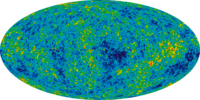
Photo from wikipedia
Interacting dark energy (IDE) scenario assumes that there exists a direct interaction between dark energy and cold dark matter, but this interaction is hard to be tightly constrained by the… Click to show full abstract
Interacting dark energy (IDE) scenario assumes that there exists a direct interaction between dark energy and cold dark matter, but this interaction is hard to be tightly constrained by the current data. Fast radio bursts (FRBs) will be seen in large numbers by future radio telescopes, and thus they have potential to become a promising low-redshift cosmological probe. In this work, we investigate the capability of future FRBs of constraining the dimensionless coupling parameter β in four phenomenological IDE models. If we fix the FRB properties, about 105 FRB data can give constraints on β tighter than the current cosmic microwave background data in the IDE models with the interaction proportional to the energy density of dark energy. In all the IDE models, about 106 FRB data can achieve the absolute errors of β to less than 0.10, providing a way to precisely measure β by only one cosmological probe. Jointly constraining the FRB properties and cosmological parameters would increase the constraint errors of β by a factor of about 0.5–2.
Journal Title: Journal of Cosmology and Astroparticle Physics
Year Published: 2022
Link to full text (if available)
Share on Social Media: Sign Up to like & get
recommendations!